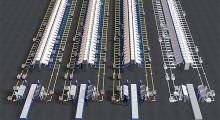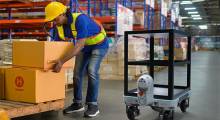Many companies have turned to mobile robots to boost efficiency and flexibility. These autonomous devices offer various benefits, enabling businesses to thrive in increasingly competitive markets.
Mobile robots are revolutionizing operations across various sectors. They are particularly effective in warehouses, where they can help streamline tasks such as picking, packing, and transportation. These devices can navigate complex environments with sophisticated algorithms and sensors, demonstrating exceptional agility.
Moreover, mobile robots are an excellent solution to labor shortages, as they can operate continuously without fatigue or breaks. They significantly lower the risk of workplace injuries by taking over dangerous tasks.
These versatile machines are not restricted to the confines of the warehouse floor. From delivering goods to customers' doors to providing telemedicine services in healthcare facilities, mobile robots are transforming how companies do business.
The implementation of mobile robots requires careful planning and consideration. It is essential to assess your organization's needs thoroughly and seek the advice of experienced professionals. With the right approach, you can use these innovative machines to optimize your business operations.
Mobile robots can automate complex tasks, making them a promising way for businesses to stay competitive.
AMRs offer advantages
Autonomous mobile robots (AMRs) are at the forefront of advancements in the robotics industry. Unlike automated guided vehicles (AGVs), these self-navigating systems can operate independently in uncontrolled environments without the need for human guidance or fixed pathways.
AMRs have sensors and onboard computing power that enable them to perceive their surroundings, create maps of their environments, and make decisions on path planning. This technology is commonly used in industries such as warehousing and manufacturing to optimize processes by automating tasks such as materials handling and intralogistics.
Unlike traditional automated systems, such as conveyor systems requiring fixed infrastructure, AMRs can navigate dynamically adjusted paths to adjust to environmental or task changes. This adaptability makes them an economically viable solution for companies looking to automate without significant facility modifications.
Challenges remain
The implementation of AMRs is not without its challenges. Technical issues such as reliable object detection and avoidance, efficient path planning, and safe human-robot interaction are ongoing research and development areas.
In addition, there are regulatory considerations, as autonomous systems in public spaces are still subject to evolving legislation and standards.
Although mobile robots are already having a significant effect on industries such as manufacturing and warehousing, their full potential is yet to be realized. The continued advancement of this technology will undoubtedly open new avenues for automation and efficiency, driving future robotics innovation and adoption.
Examples of mobile robots
There are several types of mobile robots, each with its unique functionalities and applications:
- AGVs follow a predetermined path guided by wires, magnets, or markers. These robots are ideal for transporting goods from one location to another in manufacturing, logistics, and e-commerce operations.
- AMRs possess advanced capabilities to navigate in an uncontrolled environment without physical markers or guides. They use technologies like lidar and computer vision to map their surroundings and avoid obstacles. They offer more flexibility than AGVs, which move along fixed routes. Delivery, hospitality, inventory, and self-driving forklifts are examples of self-navigating robots.
- Drones: Also known as uncrewed aerial vehicles (UAVs), these robots use software-controlled flight plans that work with GPS. Drones are used in various fields like surveying, delivery services, and agriculture.
- Autonomous underwater vehicles (AUVs): These robots function in underwater environments for applications like oceanography, oil and gas exploration, and archaeology.
Prospective users should evaluate the mobile robots whose designs best address the demands of the task at hand.
Mobile robots can provide multiple benefits
AMRs and related systems can help businesses in various sectors in the following ways:
- Increased efficiency: Robots can operate 24/7, significantly increasing productivity by learning and adapting to new routes, increasing operational efficiency.
- Cost savings: While the initial investment may be high, robots can significantly save by reducing labor costs in the long run.
- Improved accuracy: Mobile robots can reduce errors in tasks such as inventory tracking, providing more accurate and consistent results than human workers.
- Safety: AMRs promise to reduce human workers' injury risk by handling tasks in hazardous environments.
- Scalability: Businesses can quickly scale operations by deploying more robots in their fleets during peak periods, providing flexibility.
- Real-time data collection: AMRs can collect and analyze data in real time, providing businesses with valuable decision-making insights.
- Reduced footprint: Unlike traditional fixed automation, AMRs require less space as they do not need fixed paths or tracks.
- Easy integration: AMRs can be easily integrated into warehouse management systems (WMS), reducing implementation time.
In the rapidly evolving technology landscape, mobile robots stand out, with innovations transforming industries and setting new standards for efficiency and productivity.
About the author
John Levan is a professional freelance writer for AxControl.com. A graduate of Alvernia University with a B.A. and California State University with an M.A., he is a former manufacturing business owner now specializing in writing about manufacturing topics. This column is reposted with permission.
Editor's note: For more about how mobile robots can add operational agility, see Robotics 24/7's October Special Focus Issue.
Article topics
Email Sign Up
















